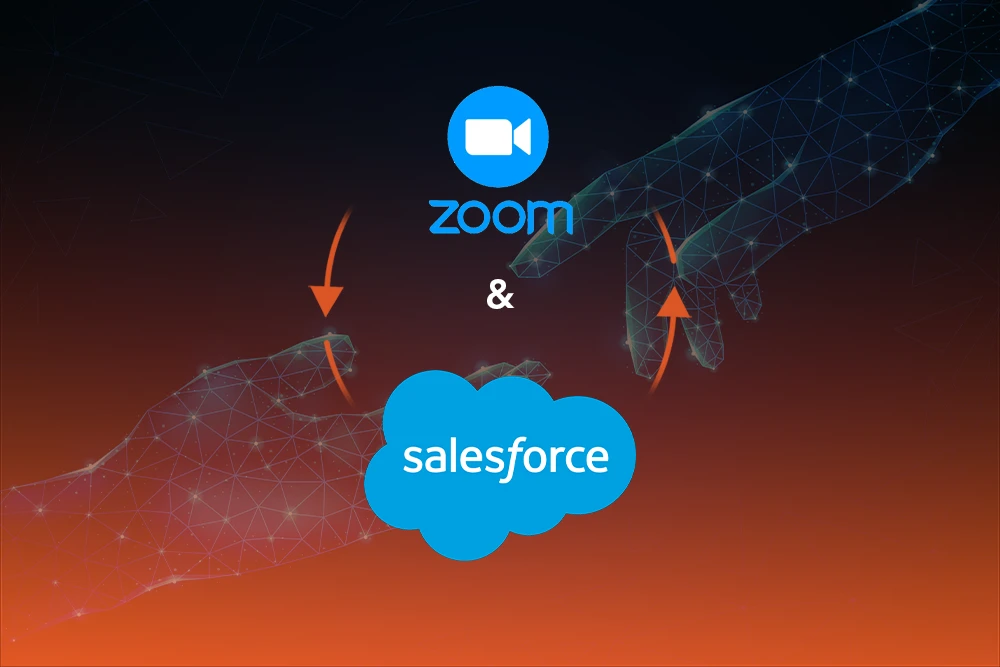
The average sales rep spends just 28% of their time actually selling. The rest is eaten up by admin work, like logging meeting notes and updating CRM records. But here’s the good news: tools like Zoom Salesforce integration are flipping the script by automating meeting data entry, streamlining follow ups and syncing customer conversations right where they matter — in Salesforce.
In this guide, we’ll show you exactly how to bring these platforms together, why it matters and what it means for your sales and service teams in 2025.
Zoom is a video call app but now it’s become a full blown communications platform. In 2025, Zoom includes video meetings, webinars, chat, whiteboards, AI assistants and even telephony. With more hybrid workforces than ever, it continues to dominate the virtual collaboration space.
Teams now use Zoom to manage everything from internal check-ins to high stakes sales demos. Thus, it is highly adaptable because it’s simple, reliable and scalable. Plus, Zoom also knows the value of playing well with others and supports integrations with major platforms like Salesforce. A Zoom integration with Salesforce creates a seamless experience that eliminates data silos and cuts down on manual tasks.
Zoom offers a native integration with Salesforce that connects your video meetings, webinars and phone calls directly into your CRM. This makes it easier for sales reps, marketers and support teams to keep track of customer interactions without jumping between apps. The integration also supports the newly acquired Slack, further expanding your collaboration toolkit.
With Zoom integration with Salesforce, users can schedule, launch and manage Zoom meetings right from the Salesforce platform. It also syncs attendance data, call logs and webinar registrations automatically, cutting down manual data entry and improving accuracy.
Here’s where the magic happens. On their own, Zoom and Salesforce are powerful tools. But together? They unlock game changing efficiencies. Let’s break down why Zoom Salesforce integration is a must in 2025:
Sales reps waste valuable time logging call notes, setting follow up reminders and tracking meeting outcomes. With Zoom Salesforce integration, all that admin work becomes automated.
That means your reps stay focused on selling, not typing.
Every interaction from the first discovery call to the final contract can be tracked in Salesforce. With Zoom to Salesforce integration, you get a complete history of communication with each contact.
In short, no one has to dig through emails or ping colleagues for updates. It’s all right there.
Let’s be honest: follow ups often slip through the cracks. But when Zoom and Salesforce are connected, follow up tasks and reminders can be triggered automatically.
This makes sales cycles shorter and close rates higher which is something every team wants.
Your meetings are full of valuable insights but only if you can access them. Zoom Salesforce integration brings that data into your CRM, where it can be measured and optimized.
Now, you can answer those questions without pulling data from five different tools.
With Zoom’s calendar integrations and Salesforce workflows, setting up a meeting is fast and painless.
No more “Does Tuesday at 3 work for you?” email chains.
Here’s how the Zoom Salesforce integration actually works:
Once integrated, users can schedule Zoom meetings directly from Salesforce records like Leads, Contacts or Opportunities. This saves time and reduces the risk of scheduling errors.
Every Zoom call or meeting is logged in Salesforce under the related record. You get detailed activity histories, including call duration, participants and notes.
Zoom webinars create Salesforce campaigns automatically. Webinar attendees sync to contact lists, enabling easier follow up and nurturing.
Sales reps can use Zoom’s soft phone dialer embedded in Salesforce to make and receive calls. This feature allows them to take notes during calls and save them directly to contact records.
Ready to get started? Let’s walk through how to set up Zoom integration with Salesforce in 2025.
Before jumping in, make sure you meet these basic requirements:
Pro tip: Install it in a sandbox environment first, then push to production after testing.
After installation:
This step enables two way data flow between platforms.
This is where the magic happens. You’ll set up how Salesforce handles Zoom data.
These settings let you fully customize your Zoom to Salesforce integration to fit your workflow.
Make it easy for users to schedule and start meetings directly in Salesforce.
Now your team won’t have to leave Salesforce to meet with prospects.
Before rolling out to the full team:
Testing helps avoid major hiccups later.
Change only works when people use it. Provide short, visual training to show reps how to:
A simple 15 minute walkthrough or a quick Loom video can go a long way.
In today’s business world, speed, automation and customer visibility are everything. The Zoom Salesforce integration checks all those boxes. By cutting down on admin tasks and giving you real time access to meeting insights, it helps your team move faster and smarter. That’s why integrating Zoom with Salesforce is a no brainer in 2025.
Want expert help setting it up? PixelConsulting specializes in Salesforce integrations and can help you get everything running smoothly, no tech headaches required. Get in touch now!
Zoom offers a basic integration with Salesforce, but some advanced features (like meeting transcription or AI summaries) may require premium Zoom plans or third party tools.
Once connected, your Zoom account syncs meeting details, participants, recordings and notes directly to Salesforce. You can configure which data flows where based on your needs.
Yes, Zoom Phone can also be integrated into Salesforce to track voice calls, recordings and call logs. It's great for inside sales or support teams.
You'll need admin access to both platforms, the Zoom Salesforce app (available via AppExchange) and API access enabled. Some configuration or developer support may be needed for complex setups.
Yes, the integration logs who attended, how long they stayed and even includes engagement metrics. Great for tracking customer interest and internal KPIs.
Read Also: Gong vs Salesforce